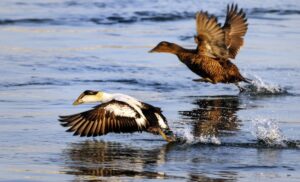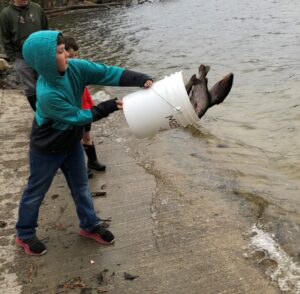Time to oil up the pea shooter, check out the decoys, waterproof your boots, etc. Monday, October 10 begins the hunting seasons for Regular Geese and Ducks in our area. Its important that you check the waterfowl regulations for there is a myriad of regulations, including the use of non-toxic shot, HIP compliance, State and Federal permits required, kinds and numbers of ducks that can be harvested, etc. You are requested to report all banded bird information to www.reportband.gov. Don’t forget to wear your personal floatation vest if applicable.
Incidentally, Highly Pathogenic Avian Influenza (HPAI) has been detected in domestic and wild birds in MA. Because common eiders were impacted by HPAI, hunters across the Atlantic flyway are being asked to voluntarily avoid shooting hens and young, brown eiders this season.
Next Saturday, October 15, the ringneck pheasant, ruffed grouse, cottontail rabbit, snowshoe hare and coyote seasons open statewide. Remember, this year there is a new pheasant/quail permit which is required for pheasant hunters. It costs $4.00 this year. As previously noted, it is imperative that you check and abide by the regulations covering these game species.
The woods are busy this time of year so be careful. Bring some tick protection spray along and, remember, no hunting on Sundays in Massachusetts.
Bear hunting season off to a good start
According to preliminary figures provided by MassWildlife some 153 black bears were harvested statewide in this year’s September bear hunting season. That compares with 112 that were taken last year. According to DFW Western District Supervisor, Andrew Madden, it is a “solid number” for them and puts them on pace for a good overall season.
The second bear season opens on November 7 and runs to November 26
Lately, some bear hunters have expressed concern about shooting a bear that is collared. Their concern is whether or not people should eat the meat that has been previously immobilized by a dart. I took that question to David Wattles, DFW Black Bear & Furbearer Biologist and here is his response:
“It is perfectly safe to harvest and eat a bear that is ear tagged or collared. The ear tags enable us to identify the bear, so we can determine the last time it was handled. If we had a bear that was very recently handled and taken in the hunting season, we would notify the hunter not to consume it. That being said, it is safe to consume meat from a bear that has received immobilization drugs 15 days after handling. It is very common practice for bears to be immobilized, tagged, hunted, and eaten throughout the U.S. without negative results.”
“I should note” he wrote, “that we also make every effort not to handle bears during or shortly before hunting season. None of our collared bears have been handled since late June and the vast majority of them not since March or before. Our trapping season ends in early July and only bears relocated in emergency situations would have been handled since then. I believe there are at most only 2-3 in the whole state since July and all of those would be safe to consume by now.”
Tri-Club skeet shooting results
Bill Stanard, spokesman for the Sheffield Sportsmen’s Club, reported the results of the Tri-Club Skeet Shooting Tournament which took place last Sunday after two years of no tournament because of the covid 19 pandemic. The Sheffield Sportsmen’s Club won.
The scores were: Sheffield – 1,348, Stockbridge Sportsmen’s Club – 1,270 (second) and Lee Sportsmen’s Association – 1,258. (third)
Ryan Shimmon was high scorer for Sheffield with scores of 45,46 and 49 out of 50 shots.
Fall trout stocking is underway
MassWildlife has begun its trout stockings here in the Western District. As of October 3, they have stocked the following waters: Stockbridge Bowl, Onota Lake, Lake Buel, Goose Pond, Laurel Lake, North Pond, Windsor Lake, Windsor Pond, Otis Reservoir, Richmond Pond and Ashfield Lake. They have also stocked the Deerfield and East Branch of the Westfield River (C&R). With the exception of Ashfield Lake, which was stocked with brown trout, all of the other waters received stockings of rainbow trout.
DFW trout stocking program questioned
From time to time, I receive correspondence from readers expressing their opinions on items written in this column. The following is one that I received from a close friend and well- known and respected local environmentalist/conservationist. Far from being an expert, the letter probably should have been forwarded to the DFW, and a better response given, but because of our friendship, I responded as following:
Question: “I completely support protecting and restoring brook trout habitat! But why on earth does DFW stock non-native trout that can out compete our native brookies for food? I oppose DFW wasting money on fish stocking. What do you think?”
Response: Your questions regarding the stocking policy of the DFW with regard to brook trout is bona-fide and deserves a serious response. I will give you my take on it.
As you probably know, the only native trout in the eastern US, were brook trout (actually char). They were plentiful and easy to catch and our forefathers were greedy (or hungry) and caught more than their share, resulting in bringing the numbers down to near extinction. Surviving populations existed only in the remotest, most difficult places to access such as in Maine, Labrador, and a few secret spots here in the Berkshires.
Sometime in the late 1800’s fish biologists began to fear that the native brook trout population would be wiped out completely if no action was taken and because of that, began to look into importing and introducing other types of trout to our area. It was either that or ban trout fishing altogether, which no one would accept.
Brown Trout from Europe and Rainbow Trout from out west were introduced to our waters with the probable thought being that some trout fishing was better than no trout fishing (and eating). The new, non-native trout took hold nicely and provided anglers with fishing (and) immeasurable enjoyment (catching them.) Unfortunately, the larger stocked trout out-competed the wild trout (for food) for a while until the warmer months when the wild guys have the advantage of knowing where to find cooler waters necessary for their survival.
Fast forward to now. If brown and rainbow trout fishing was not allowed here, there would probably be no trout fishing whatsoever. Yes, DFW stocks hatchery brook trout, but they would be caught out fairly rapidly and are not as tough or resilient as the native guys. (Put and take, thus leaving the native guys alone.)
MassWildlife is generally careful about where they stock the non-native fish, taking pains to leave wild brook habitat pretty much alone or stocking at the lower, larger reaches of the rivers while leaving the upper, cooler reaches of the river to the wild brookies. I say generally as there are a few streams which are stocked which would perhaps be better off left alone. But those streams (usually) are stocked mainly in neighborhoods for kids to fish and they want to go home with some nice fish.
The raising and stocking of these non-native trout, has provided a lot of employment as well as enjoyment for anglers over the years. In some cases, it got the kids out of doors and have inspired youths to take up the sport which often times led to interests in other environmental issues. (I did).
Many kids don’t understand the concept of preserving the wild brookie and are only interested in catching a trout and bringing it home to mom or dad. (I can speak from experience because each year, the Berkshire County League of Sportsmen has a Youth Outreach fishing day, mainly for kids who would otherwise not have the opportunity to go fishing. You should see the look of glee on their faces when they catch a trout.)
By not stocking them, are we not depriving kids of that pleasure?
So, as you see, the answer to your question is complicated. And you are not alone in your concerns. There is a movement by some groups such as the Native Fish Coalition to do less such stocking.
Far from a perfect solution, I personally think the MassWildlife is addressing the trout stocking issue fairly well.


